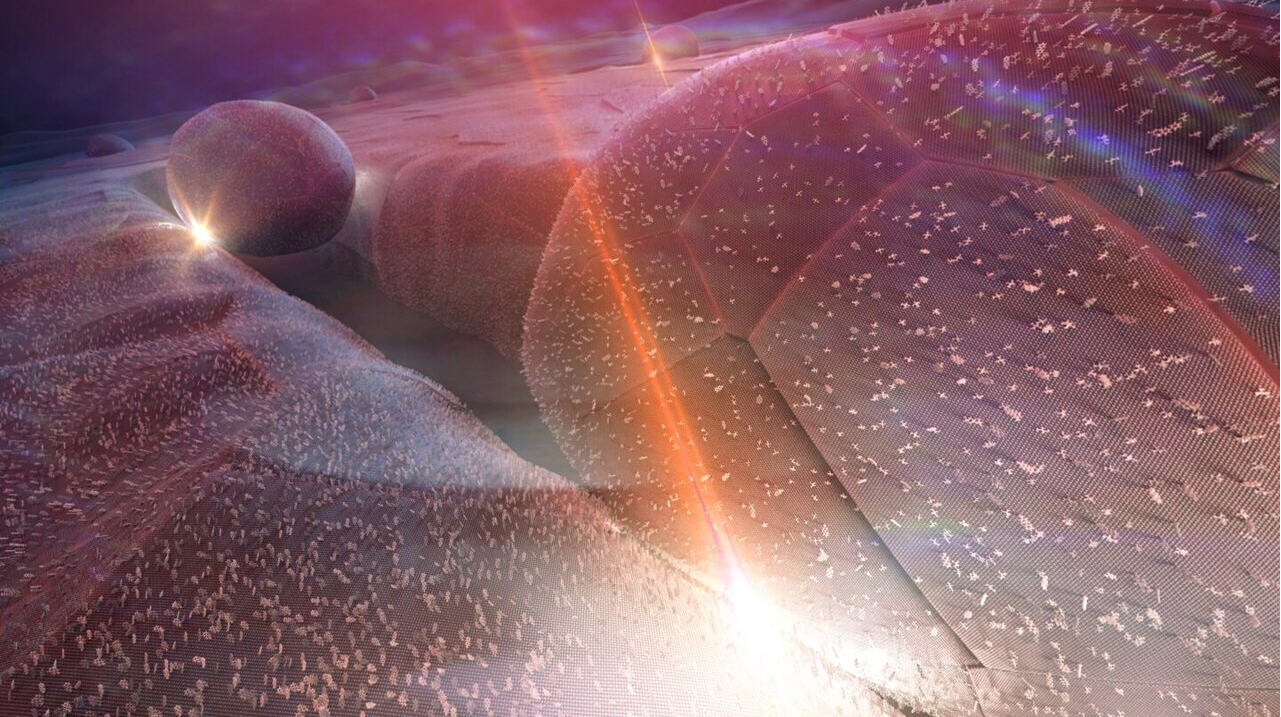博文
Science:分子装置将红外线转化为可见光
 精选
精选
||
Science:分子装置将红外线转化为可见光
诸平

Artistic view of the nanoparticle-in-groove plasmonic cavities. Molecules cover the gold film and are sandwiched between the groove and the 150-nm large nanoparticle. The infrared signal of interest comes from below the substrate while the pump laser providing energy for upconversion comes from the top. Both are focused by the cavity onto the molecules, and interact with their internal vibrations to generate an upconverted copy of the infrared signal at visible frequencies (bright spot). Credit: Nicolas Antille
据瑞士洛桑联邦理工学院(Ecole Polytechnique Federale de Lausanne简称EPFL)2021年12月2日提供的消息,瑞士(EPFL)、中国(China)、西班牙(Spain)以及荷兰(Netherlands)的研究人员合作,使分子装置能够将红外线转化为可见光(Molecular device turns infrared into visible light)。
光是一种电磁波:它由在空间中传播的振荡电场和磁场组成。每种波都有其频率的特征,频率是指每秒振荡的次数,单位是赫兹(Hertz简称Hz)。我们的眼睛可以探测到400 - 750万亿赫兹或400 - 750太赫兹(terahertz简称THz)之间的频率,这定义了可见光谱。手机相机的光传感器可以探测到300THz的频率,而光纤网络连接所用的探测器的灵敏度约为200 THz。
在较低的频率(lower frequencies)下,光传输的能量不足以触发我们眼睛中的光感受器和许多其他感受器,这是一个问题,因为在100 THz以下的中红外和远红外光谱(mid- and far-infrared spectrum)中有丰富的信息。例如,一个表面温度为20 ℃的物体发出高达10 THz的红外线,可以通过热成像“看到”。此外,化学物质和生物物质在中红外波段具有明显的吸收带,这意味着我们可以通过红外光谱远程无损地识别它们,红外光谱有多种应用。
将红外线转化为可见光(Turning infrared into visible light)
EPFL、中国武汉理工大学(Wuhan Institute of Technology)、西班牙巴伦西亚理工大学(Valencia Polytechnic University)和荷兰原子和分子物理学研究所(AMOLF)的科学家们现在开发了一种新的方法,通过将红外线的频率改变为可见光(visible light)的频率来探测红外线。该设备可以扩展“视线”的一般可用和高灵敏度探测器的可见光远到红外。这项突破于2021年12月2日已经在《科学》(Science)杂志网站发表——Wen Chen, Philippe Roelli, Huatian Hu, Sachin Verlekar, Sakthi Priya Amirtharaj, Angela I. Barreda, Tobias J. Kippenberg, Miroslavna Kovylina, Ewold Verhagen, Alejandro Martínez, Christophe Galland. Continuous-Wave Frequency Upconversion with a Molecular Optomechanical Nanocavity. Science, 2 Dec 2021, 374 (6572): 1264-1267. DOI: 10.1126/science.abk3106. http://www.science.org/doi/10.1126/science.abk3106
变频不是一件容易的事。由于能量守恒定律,光的频率是一种基础,它不能轻易地通过在表面上反射光或通过材料来改变。
研究人员通过一种介质——微小的振动分子——给红外光增加能量,从而解决了这个问题。红外光直接照射到分子上,在分子上转化为振动能。同时,一束更高频率的激光束冲击同样的分子,提供额外的能量,并将振动转化为可见光。为了促进转化过程(conversion process),分子被夹在金属纳米结构之间,通过将红外光和激光能量集中在分子上,充当光学天线(optical antennas)。
一束新光(A new light)
该研究的负责人、EPFL基础科学学院的Christophe Galland教授说:“这种新设备有很多吸引人的功能。首先,转换过程是连贯的,这意味着所有存在于原始红外光(original infrared light)中的信息都忠实地映射到新生成的可见光上。它允许用标准的探测器进行高分辨率红外光谱分析,就像在手机相机中发现的那样。其次,每个设备的长度和宽度都只有几微米,这意味着它可以被整合到大型像素阵列中。最后,该方法具有高度的通用性,可以通过简单地选择具有不同振动模式的分子来适应不同的频率。”
该研究的第一作者陈文博士(Dr. Wen Chen音译)警告说:“然而,到目前为止,该装置的光转换效率仍然很低。我们现在正集中力量进一步对其进行改善。”这是迈向商业应用的关键一步。
上述介绍,仅供参考。欲了解更多信息,敬请注意浏览原文或者相关报道。
Molecules have rich signatures in their spectra at infrared wavelengths and are typically accessed with dedicated spectroscopic instrumentation. Chen et al. and Xomalis et al. report optomechanical frequency upconversion from the mid-infrared to the visible domain using molecular vibrations coupled to a plasmonic nanocavity at ambient conditions (see the Perspective by Gordon). Using different nanoantenna designs, one with a nanoparticle-on-resonator and the other with nanoparticle-in-groove, both approaches show the ability to upconvert the mid-infrared vibrations of the molecules in the nanocavity to visible light wavelengths. The effect could be used to simplify infrared spectroscopy, possibly with single-molecule sensitivity. —ISO
Coherent upconversion of terahertz and mid-infrared signals into visible light opens new horizons for spectroscopy, imaging, and sensing but represents a challenge for conventional nonlinear optics. Here, we used a plasmonic nanocavity hosting a few hundred molecules to demonstrate optomechanical transduction of submicrowatt continuous-wave signals from the mid-infrared (32 terahertz) onto the visible domain at ambient conditions. The incoming field resonantly drives a collective molecular vibration, which imprints a coherent modulation on a visible pump laser and results in upconverted Raman sidebands with subnatural linewidth. Our dual-band nanocavity offers an estimated 13 orders of magnitude enhancement in upconversion efficiency per molecule. Our results demonstrate that molecular cavity optomechanics is a flexible paradigm for frequency conversion leveraging tailorable molecular and plasmonic properties.
https://blog.sciencenet.cn/blog-212210-1315057.html
上一篇:[转载]杨六省:√2不是有理数的反论题到底是什么?
下一篇:Science:科学家们记录了一种前所未有的物质态 ——量子自旋液体的存在